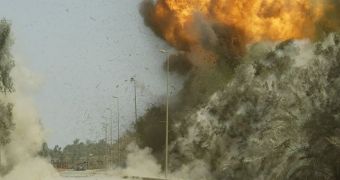A new line of research, focused on the negative effects that explosion-generated blast waves have on the human brain even outside their so-called action radius, may lead to a new generation of improved helmets for soldiers, and also to a reduction in related head injuries. The team of experts investigating the phenomenon has reached the conclusion that even non-lethal blasts pack sufficient strength to significantly bend the skull. This places enormous pressure on the brain and causes damage, even without direct impact, the researchers say, quoted by ScienceDaily.
In charge of the new study were US Department of Energy (DOE) Lawrence Livermore National Laboratory (LLNL) scientists Willy Moss and Michael King, who worked closely together with colleague Eric Blackman, a scientist at the University of Rochester. The team used numerical hydrodynamic computer simulations to evaluate the threat posed by seemingly harmless and non-lethal blasts on the human brain. According to their conclusions, traumatic brain injury (TBI) can occur even without the skull breaking or fracturing.
The scientists explain that it was advancements in body armor that, counter-intuitively, led to this new line of research. They explain that, as the number of fatalities associated with explosion waves decreased – as a natural consequence of the fact that servicemen and women had a much more efficient type of body armor on –, the number of TBI cases increased dramatically. The two believe that the trend was always there, but that is was “masked” by all the casualties. In their 3D models, the experts noticed that even non-lethal blast waves, of only one bar above normal atmospheric pressure, were enough to trigger skull flexure, and large mechanical strains on the brain.
“The blast wave sweeps over the skull like a rolling pin going over dough,” King, who is the LLNL co-principal investigator of the new study, explains. “This is large enough to generate potentially damaging loads in the brain. The possibility that blasts may contribute to traumatic brain injury has implications for injury diagnosis and improved armor design,” Moss adds. “By comparing the effect of blasts on the head with the effect of head impacts we'd be able to make some sense of the distinct mechanisms of injury, the damage a solider might incur, and how a helmet might be designed to minimize both,” Blackman concludes.
A thorough presentation of the team's experiments appears online in the August 26th issue of the respected scientific journal Physical Review Letters.

 14 DAY TRIAL //
14 DAY TRIAL //